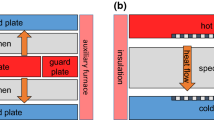Conclusions
The investigation showed that the thermal conductivity of inserts intended for heating the feeder part of the ingot varies considerably, notably at 600–900°C.
The thermal conductivity of the inserts is influenced only slightly by the method of production and by the composition of the material.
A comparison of the coefficients of heat retention showed that insert No. 1 is greatly superior to the remainder in this respect and that the heat insulation properties of the inserts differ considerably from those of the chamotte brick used as lining for the feeder heads.
Similar content being viewed by others
Literature cited
V. V. Pustovalov, Thermal Conductivity of Refractories [in Russian], Metallurgiya, Moscow (1966), 84 pages.
A. F. Chudnovskii, Thermophysical Characteristics of Dispersed Materials [in Russian], Fizmatgiz, Moscow (1962), 456 pages.
Author information
Authors and Affiliations
Additional information
Translated from Ogneupory, No. 9, pp. 18–22, September, 1974.
Rights and permissions
About this article
Cite this article
Schneerov, Y.A., Polyakov, V.F., Minevich, V.Y. et al. The thermophysical properties of heat insulation inserts. Refractories 15, 544–547 (1974). https://doi.org/10.1007/BF01287163
Issue Date:
DOI: https://doi.org/10.1007/BF01287163



